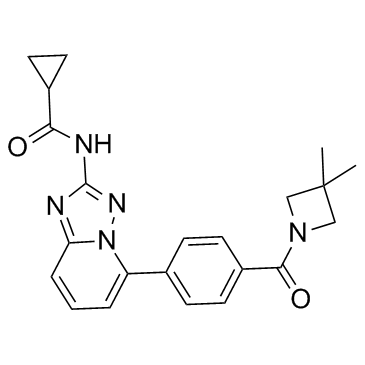In mutated cell lines, there was an estimated decrease of 21% in viability for each unit increase in enzastaurin concentration. Based upon the estimated equations, the EC50 values are 9.15 mM and 2.85 mM for wild type and mutated cell lines, respectively. There is little evidence for differences in response in enzastaurin concentrations of 1 mM or less. At concentrations of 2 mM or above, there was a statistically significant reduction in the viability of mutated cell lines compared with wild type. To better understand the differential responses of UM cells based on GNAQ mutational status, we investigated cell cycle progression alterations with drug exposure. Enzastaurin treatment for 48 hours significantly increased the G1 population while decreasing the S population in all three cell lines harboring GNAQ mutations. In agreement with these findings, enzastaurin significantly decreased BrdU incorporation in mutant cell lines. These results suggest that enzastaurin induced G1 arrest in the cell lines harboring mutations. In comparison, the G1 population of the wild type cell lines was either unaltered or decreased by enzastaurin. A significant increase in the G2/M population was observed in Ocm1 and Mel285 cells. A mild increase in the S population and a significant increase in BrdU uptake were observed in Ocm3 cells treated with 5 and 10 mM enzastaurin. As enzastaurin is known to induce apoptosis in many types of cancer cells, we next examined whether enzastaurin induced apoptosis of UM cells using Annexin V-FITC staining. Treatment with 4 mM enzastaurin for 72 hours induced a slight increase in apoptosis in mutant cell line 92.1 but not in the wild type cell line C918. Because enzastaurin is highly bound by serum protein, we tested if reduced serum concentrations would increase its apoptotic effects. In the presence of 1% serum, treatment with 5 mM enzastaurin for 72 hours induced substantial apoptosis in the cell lines Mel202, 92.1 and Omm1.3 harboring GNAQ mutations, and in the wild type cell lines Ocm1, but failed to do so in cell line  C918 which is wild type for GNAQ. An increase in cleaved caspase-3 fragments was also observed in enzastaurin-treated Mel202, 92.1 and Omm1.3 mutant cells and Ocm1 wild type cells, but not C918 cells. These findings suggest that UM cells carrying GNAQ mutations and some GNAQ wild type/BRAF mutant cells are more sensitive to the apoptotic activity of enzastaurin and that enzastaurin exerted increased antiproliferative effect on GNAQ mutant UM cells through ICG-001 induction of G1 arrest and apoptosis. GNAQ mutations at codon 209 have been recently found in nearly 50% of UM patients. These mutations can lead to Niraparib activation of a number of cell signaling pathways. In the present study, we demonstrate for the first time that UM cell lines harboring GNAQ mutations are more sensitive to the antiproliferative effects of the PKC inhibitor enzastaurin than those possessing wild type GNAQ. Enzastaurin inhibits proliferation of mutant UM cells through induction of G1 cell cycle arrest and apoptosis. We have further characterized signaling and molecular mechanisms underlying differential responses of GNAQ wild type and mutant cells to enzastaurin. The PI3K/Akt and MAPK pathways are frequently activated in malignant tumors. Erk1/2 activation is commonly found in UM, independent of GNAQ, RAS, and BRAF mutational status, and are crucial for UM development. GNAQ mutations have been reported to be oncogenic through activating the Erk1/2 pathway in UM cells. In the current study, we show that enzastaurin reduced Erk1/2 phosphrylation in all three GNAQ mutant UM cell lines and in one wild type cell line.
C918 which is wild type for GNAQ. An increase in cleaved caspase-3 fragments was also observed in enzastaurin-treated Mel202, 92.1 and Omm1.3 mutant cells and Ocm1 wild type cells, but not C918 cells. These findings suggest that UM cells carrying GNAQ mutations and some GNAQ wild type/BRAF mutant cells are more sensitive to the apoptotic activity of enzastaurin and that enzastaurin exerted increased antiproliferative effect on GNAQ mutant UM cells through ICG-001 induction of G1 arrest and apoptosis. GNAQ mutations at codon 209 have been recently found in nearly 50% of UM patients. These mutations can lead to Niraparib activation of a number of cell signaling pathways. In the present study, we demonstrate for the first time that UM cell lines harboring GNAQ mutations are more sensitive to the antiproliferative effects of the PKC inhibitor enzastaurin than those possessing wild type GNAQ. Enzastaurin inhibits proliferation of mutant UM cells through induction of G1 cell cycle arrest and apoptosis. We have further characterized signaling and molecular mechanisms underlying differential responses of GNAQ wild type and mutant cells to enzastaurin. The PI3K/Akt and MAPK pathways are frequently activated in malignant tumors. Erk1/2 activation is commonly found in UM, independent of GNAQ, RAS, and BRAF mutational status, and are crucial for UM development. GNAQ mutations have been reported to be oncogenic through activating the Erk1/2 pathway in UM cells. In the current study, we show that enzastaurin reduced Erk1/2 phosphrylation in all three GNAQ mutant UM cell lines and in one wild type cell line.